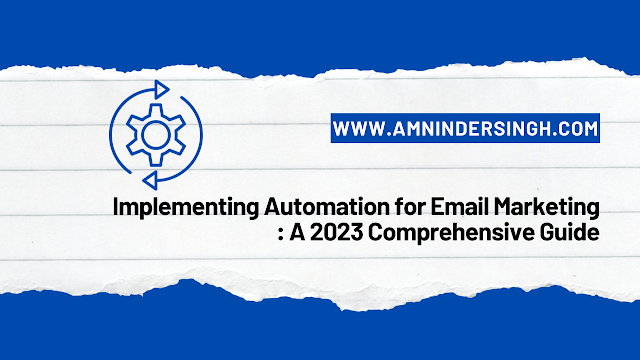Email marketing automation is a powerful tool that can save you time, increase the efficiency of your marketing campaigns, and provide a personalized experience for your subscribers.
This comprehensive guide will walk you through the steps to implement email marketing automation effectively.
Understanding Email Marketing Automation
1.1 What is Email Marketing Automation?
Email marketing automation involves using software and technology to send emails to your subscribers based on predefined triggers, actions, or conditions. These automated emails can include welcome messages, product recommendations, transactional emails, and more.
1.2 Benefits of Email Marketing Automation
Time Efficiency: Automation reduces manual tasks, allowing you to focus on other aspects of your business.
Personalization: Send tailored messages to specific segments of your audience.
Increased Engagement: Timely and relevant emails lead to higher open and click-through rates.
Revenue Generation: Targeted emails can boost sales and conversions.
Consistency: Ensure a consistent flow of communication with your audience.
1.3 When to Use Email Marketing Automation
Consider using email marketing automation when:
You have a sizable email list.
You want to nurture leads and build customer relationships.
You want to streamline your marketing efforts.
You have specific triggers or events you want to respond to automatically.
Setting Up Your Email Marketing Automation
2.1 Define Your Goals
Determine your objectives for email marketing automation. Are you trying to increase sales, onboard new users, or provide valuable content? Clear goals will guide your strategy.
2.2 Choose the Right Email Marketing Platform
Select a reliable email marketing platform that offers automation features. Popular options include Mailchimp, HubSpot, and ActiveCampaign. Ensure it integrates with your CRM and e-commerce systems.
2.3 Build and Organize Your Email List
Maintain a clean and up-to-date email list. Remove inactive subscribers and categorize contacts by their preferences and behaviors.
2.4 Segment Your Email List
Segmentation is crucial for targeted messaging. Divide your list into groups based on demographics, purchase history, engagement, and more. This allows you to send highly relevant content.
Creating Automated Email Campaigns
3.1 Welcome Emails
Welcome emails are the first impression. Send a series of automated emails to new subscribers, introducing your brand and guiding them through your offerings.
3.2 Drip Campaigns
Drip campaigns involve a series of emails sent at timed intervals. Use them for lead nurturing, onboarding, or delivering a course.
3.3 Abandoned Cart Emails
Recover potential sales by sending automated emails to users who abandon their shopping carts. Include product reminders and incentives.
3.4 Product Recommendations
Leverage data and automation to suggest products or content that match a subscriber’s previous behavior or preferences.
3.5 Event Triggered Emails
Set up triggers for events like birthdays, anniversaries, or specific user actions (e.g., clicking a link). Send personalized emails based on these triggers.
Personalization and Content Strategy
4.1 Personalization
Personalize subject lines, content, and recommendations based on user behavior and data. Personalization can significantly boost engagement.
4.2 Content Strategy
Plan your content calendar and ensure your emails provide value. Balance promotional and informative content to keep subscribers engaged.
4.3 A/B Testing
Regularly test different elements of your emails, such as subject lines, CTAs, and content, to optimize performance.
Monitoring and Optimization
5.1 Key Metrics to Track
Monitor key email metrics like open rates, click-through rates, conversion rates, and unsubscribe rates. Use analytics to assess the effectiveness of your automation.
5.2 A/B Testing and Optimization
Continuously improve your automated campaigns by A/B testing different elements and making data-driven adjustments.
5.3 Analyze Results and Adjust
Regularly review campaign performance and adjust your strategies accordingly. Adapt to changes in your audience’s behavior and preferences.
Compliance and Privacy
6.1 GDPR and Email Marketing
If you serve customers in the European Union, ensure your email marketing complies with GDPR regulations, including obtaining explicit consent and offering opt-out options.
6.2 CAN-SPAM Act Compliance
If you operate in the United States, follow CAN-SPAM Act guidelines, including providing an easy way for recipients to unsubscribe.
6.3 Opt-in and Opt-out Processes
Make it simple for subscribers to opt in and out of your emails. Provide clear instructions and honor unsubscribe requests promptly.
Email Marketing Automation : Conclusion
Implementing email marketing automation can transform your email campaigns by saving time, increasing engagement, and driving revenue. By following the steps outlined in this guide and continuously refining your strategies, you can harness the full potential of email marketing automation to grow your business and nurture strong customer relationships.
This article is part of our Email marketing Module
Module 7: Email Marketing
7.1 Essential Foundations of Email Marketing
7.2 Building and Managing Email Subscriber Lists
7.3 Crafting and Executing High-Impact Email Campaigns
7.4 Implementing Automation for Email Marketing
7.5 Tracking and Assessing Email Marketing Campaign Performance

